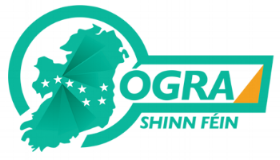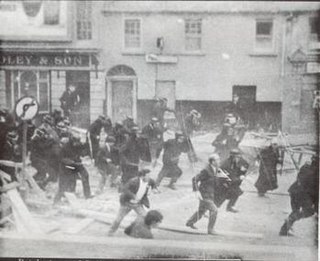| 2001 South Armagh attacks | |||
|---|---|---|---|
| Date | 9 December 2001 | ||
| Location | County Armagh, Northern Ireland | ||
| Parties | |||
| |||
| Casualties and losses | |||
| |||
The 2001 South Armagh attacks were attacks on two watchtowers and a police station in South Armagh, Northern Ireland.
| 2001 South Armagh attacks | |||
|---|---|---|---|
| Date | 9 December 2001 | ||
| Location | County Armagh, Northern Ireland | ||
| Parties | |||
| |||
| Casualties and losses | |||
| |||
The 2001 South Armagh attacks were attacks on two watchtowers and a police station in South Armagh, Northern Ireland.
On 9 December 2001, a group of 100 Irish republicans attacked two watchtowers and a police station in South Armagh, Northern Ireland. [1] The mob first attacked the Creevekeeran watchtower with petrol bombs, iron bars and bottles. The crowd then attacked nearby Drummackavall watchtower in a similar assault before moving to the Crossmaglen police station, where they breached the entrance and fired missiles and petrol bombs at security forces. Twenty-one Police Service of Northern Ireland (PSNI) officers, three British Army soldiers and three police dogs were injured. [2] [3]
The riots followed a protest by members of Sinn Féin's youth wing dissatisfied with the slow process of demilitarisation promised by the British government, a key demand of Sinn Féin in the Northern Ireland peace process. [4]
The injured forces were airlifted to hospitals, one of whom suffered severe face burns. Four people from Belfast were arrested that night. The attack was condemned by assembly members including John Fee, but Sinn Féin's Conor Murphy claimed the mob had no weapons and were met with a "violent reaction" at Crossmaglen police station, where officers fired plastic bullets that injured some of them. [4] Murphy also condemned the police's "bully boy" tactics. [5]
A PSNI spokesman said the attack was a "well-orchestrated protest that was never intended to be peaceful". In a separate incident that day rioters attacked a car in north Belfast that injured an eight-year-old girl. [6]

Conor Terence Murphy is an Irish republican Sinn Féin politician, who has served as Minister for the Economy of Northern Ireland since 2024. He has been a Member of the Legislative Assembly (MLA) for Newry and Armagh since 2015, having previously served as the Member of Parliament for Newry and Armagh from 2005 to 2015, observing the Sinn Fein policy of abstentionism.

The South Armagh Brigade of the Provisional Irish Republican Army (IRA) operated during the Troubles in south County Armagh. It was organised into two battalions, one around Jonesborough and another around Crossmaglen. By the 1990s, the South Armagh Brigade was thought to consist of about 40 members, roughly half of them living south of the border. It has allegedly been commanded since the 1970s by Thomas 'Slab' Murphy who is also alleged to be a member of the IRA's Army Council. Compared to other brigades, the South Armagh IRA was seen as an 'independent republic' within the republican movement, retaining a battalion organizational structure and not adopting the cell structure the rest of the IRA was forced to adopt after repeated intelligence failures.

Ógra Shinn Féin is the youth wing of the Irish political party Sinn Féin. Ógra Shinn Féin is active and organised throughout the island of Ireland.

During 12–16 August 1969, there was an outbreak of political and sectarian violence throughout Northern Ireland, which is often seen as the beginning of the thirty-year conflict known as the Troubles. There had been sporadic violence throughout the year arising out of the Northern Ireland civil rights campaign, which demanded an end to discrimination against Catholics and Irish nationalists. Civil rights marches had been attacked by Protestant loyalists, and protesters often clashed with the Royal Ulster Constabulary (RUC), the overwhelmingly Protestant police force.
This is a chronology of activities by the Continuity Irish Republican Army (CIRA), an Irish republican paramilitary group. The group started operations in 1994, after the Provisional Irish Republican Army began a ceasefire.
This is a timeline of actions by the Irish republican paramilitary groups referred to as the Real Irish Republican Army and New Irish Republican Army. The Real IRA was formed in 1997 by disaffected members of the Provisional IRA. Since July 2012, when Republican Action Against Drugs (RAAD) and other small republican groups merged with it, the group has been called the New IRA; although it continues to call itself simply "the Irish Republican Army".
This is a chronology of activities by the Provisional Irish Republican Army, an Irish republican paramilitary group in the 21st century.

The dissident Irish republican campaign began at the end of the Troubles, a 30-year political conflict in Northern Ireland. Since the Provisional Irish Republican Army called a ceasefire and ended its campaign in 1997, breakaway groups opposed to the ceasefire and to the peace agreements have continued a low-level armed campaign against the security forces in Northern Ireland. The main paramilitaries involved are the Real IRA, Continuity IRA and formerly Óglaigh na hÉireann. They have targeted the Police Service of Northern Ireland (PSNI) and the British Army in gun and bomb attacks as well as with mortars and rockets. They have also carried out bombings that are meant to cause disruption. However, their campaign has not been as intensive as the Provisional IRA's, and political support for groups such as the Real IRA is "tending towards zero".

From 6 to 11 July 1997 there were mass protests, fierce riots and gun battles in Irish nationalist districts of Northern Ireland. Irish nationalists/republicans, in some cases supported by the Provisional Irish Republican Army (IRA), attacked the Royal Ulster Constabulary (RUC) and British Army. The protests and violence were sparked by the decision to allow the Orange Order to march their traditional route, passing through a Catholic/nationalist neighbourhood of Portadown. Irish nationalists were outraged by the decision and by the RUC's aggressive treatment of those protesting against the march. There had been a bitter dispute over the march for many years.
During the 2012 North Belfast Riots sectarian disorder and rioting between loyalists and republicans occurred when rival parades, authorised by the Parades Commission, took place.

On 3 December 2012, Belfast City Council voted to limit the days that the Union Flag flies from Belfast City Hall. Since 1906, the flag had been flown every day of the year. This was reduced to 18 specific days a year, the minimum requirement for UK government buildings. The move to limit the number of days was backed by the council's Irish nationalists while the Alliance Party abstained from the vote; it was opposed by the unionist councillors.

The 2002 Short Strand clashes, also known as the siege of Short Strand, was a series of major sectarian violence and gun battles in and around the Short Strand area of east Belfast – a mainly Irish/Catholic enclave surrounded by Protestant communities. Although violence had occurred many times throughout 2002, this article deals with the worst episode in June.
On 12 July 2001, major rioting and civil disorder broke out in Ardoyne, north Belfast, Northern Ireland. In some of the worst rioting in years, 113 police officers were injured in clashes which followed a July 12 parade. Police were attacked when trying clear the path for about 100 Orangemen returning from the parade to go along a main road passing the Catholic Ardoyne area.
The 2010 Northern Ireland riots were riots and civil disturbance in Northern Ireland in July 2010, orchestrated by Irish republicans.
The May 2002 Belfast riots were riots that occurred in north Belfast, Northern Ireland. On Saturday May 2002, up to 800 people were involved in sectarian clashes beginning shortly after the Scottish Cup Final in which Rangers F.C. beat Celtic F.C. Petrol bombs and fireworks were thrown at Police Service of Northern Ireland (PSNI) officers. That night 28 police officers and 10 civilians were injured, including two Protestant men who were shot.
Large civil disorder broke out in north Belfast, Northern Ireland on Sunday 11 November 2001. The trouble started when republicans clashed with loyalists during a Remembrance Day service. Up to 400 Protestants and Catholics were involved in rioting in the afternoon on North Queen Street.
The 2018 Derry riots were riots and civil disturbances taking place in Derry, Northern Ireland from 8 July 2018, before the Protestant Orange Order parade. It was the first 12 July parade to take place in Derry for five years. Violence broke out in the republican Bogside area in what has been called the worst in the city in "decades". The Police Service of Northern Ireland (PSNI) has blamed the New IRA group for trying to kill police officers. Riot police fired plastic baton rounds, whilst at least 70 petrol bombs have been thrown at them.

Throughout the protracted conflict in Northern Ireland (1960s-1998), the Provisional IRA developed a series of improvised mortars to attack British Army and Royal Ulster Constabulary (RUC) security bases. The organisation also purchased both light and heavy machine guns in order to hamper the British Army supply of border bases by helicopter. The IRA fitted vehicles, specially vans and trucks, with both types of weapons. Vans, trucks and tractors were modified to transport concealed improvised mortars to a launch area near the intended target and fire them, while light and heavy trucks were employed as firing platforms mounting machine guns, particularly M60s and DShKs. Improvised armoured vehicles and heavy equipment were also used to penetrate the perimeter of fortified security bases. The IRA vehicles were often disguised as belonging to civilian companies or even government agencies.
Events from the year 2021 in Northern Ireland.
A series of riots in loyalist areas of Northern Ireland began in Waterside, Derry, on 30 March 2021. After four nights of rioting in Derry, disturbances spread to south Belfast on 2 April, where a loyalist protest developed into a riot involving iron bars, bricks, masonry and petrol bombs. Following this, civil unrest spread to Newtownabbey on 3 April, where cars were hijacked and burnt, and petrol bombs were also used against police. Carrickfergus in southern County Antrim also saw serious civil unrest on the night of 4 April and morning of 5 April, where loyalists created roadblocks to keep police out of local estates and threw petrol bombs at police vehicles.